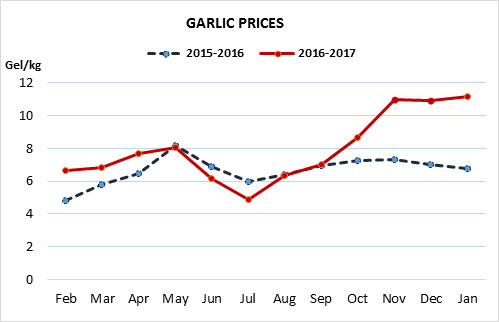Indexes
 19
February
2017
19
February
2017

 19
February
2017
19
February
2017
Food prices continue to follow the latest trends. Retail FPI shows a 2.6% increase m/m (that is, compared to January 2017) and a 4.9% decline y/y (that is, compared to February 2016). During the last two weeks, matsoni, tea, and carrots lost value (by 10.4%, 6.2%, and 6.2% respectively), whereas the prices of cabbage, greens, and eggplant increased (by 25.0%, 16.1%, and 14.9% respectively).
Higher vegetable prices are not surprising given seasonality. However, garlic prices have been continuously increasing during the last couple of months. Prices started rising in October 2016, and are now much higher (by 65%) than in 2015. Such a big difference y/y shows that increasing prices are caused by some other factors rather than seasonality.
In 2016, garlic imports to Georgia dropped by 63% in value, and by 65% in quantity, compared to 2015. Therefore, in 2016, Georgia imported less than half of the quantity that it imported in 2015. As to trade partners, Georgia imports garlic mostly from China, Turkey, and Armenia, with China is the leading import market for Georgia and the biggest garlic producer in the world. In 2015, 50% of the total quantity of imported garlic to Georgia was from China, and in 2016, this amount slightly decreased and equaled 47%, which is still high.

Such a sharp decrease in the value and volume of imports can be easily explained if one looks at the world garlic market. Poor weather conditions (rain and snow) in China back in 2015 led to a very bad harvest in 2016, causing speculation on the garlic market and driving international prices up. High worldwide prices forced Georgian importers to reduce their imports, and finally, garlic became much more expensive in Georgia as well.
This particular case emphasizes again the importance of import substitution, both for consumers and producers. Increased domestic production would save Georgian consumers from shortages of products and high prices. As to producers, switching to high-value goods will also generate additional incomes for them.





